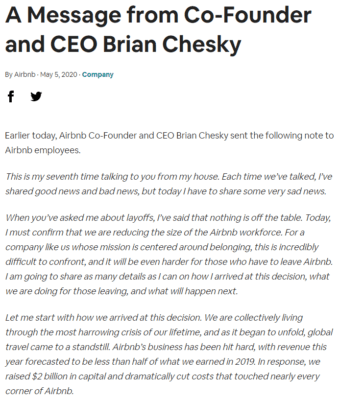It’s never an easy task delivering bad news to team members you may have worked alongside for some time. Sadly, that’s the reality currently facing many managers.
The global recession that the coronavirus pandemic has unleashed is unfolding. Lockdown measures implemented by governments worldwide have meant that economies have taken a punch to the gut. Some businesses – especially those in service industries or tourism – are being forced to implement reduced operations and redundancies in an attempt to stay afloat. In the US, 26 million jobs alone were lost in just five weeks.
On a daily basis, managers are having difficult conversations with employees.
While it’s a task that no one would anticipate, it is possible to deliver bad news sensitively and respectfully. In these challenging economic times, it’s essential that staff feel informed about what’s happening – at a company level, and an individual level. Internal communications are, of course, at the heart of this. And while every conversation will be different, there are general principles for delivering bad news. In this post, we share some tips on how to tackle this sensitive task.
Preparation: Consider Every Question
Thorough preparation is the most important step. Your employee will have lots of questions about what’s happening. They will need to know how the decision was made and the rationale behind it. They will want to know who was consulted and whether any other possibilities were considered. Have the answers ready.
 Pre-empting likely questions gives you time to prepare your responses. And it also allows you to work through how you will communicate the issues. What’s more, being fully prepared means you will feel more confident in the meeting.
Pre-empting likely questions gives you time to prepare your responses. And it also allows you to work through how you will communicate the issues. What’s more, being fully prepared means you will feel more confident in the meeting.
The employee deserves to have a full explanation of the situation. And so, for a successful outcome, it’s vital to take time on this preparatory stage.
Pick The Right Time And Place
When and where the conversation takes place can help to soften the impact of bad news. First thing on a Monday morning before the team meeting probably isn’t the best timing.
If possible, deliver the news in person. This may be challenging particularly if your employee works remotely. If it’s unavoidable, then the next best thing is a video call. Whatever you do, don’t break the news in an email or phone conversation. Instead, try putting yourself in the employee’s shoes and think about how you would want to be treated.
Once the decision has been made, it’s essential to tell the employee straight away. The longer you leave it, the harder the task will become. And, there’s an increased possibility of the rumor mill doing the job for you.
Be Direct And Stay On Point
It’s natural to want to make the conversation as painless as possible for the employee. However, when it comes to delivering bad news, honesty is the best policy. Don’t sugar-coat the situation. Be firm, be clear, and stick to the facts. Furthermore, make sure you cut to the chase quickly. Now is not the time for a lengthy discussion about the weather.
An employee’s immediate reaction is often dependent on how the news is delivered.
It’s essential, however, to show compassion. The news may well come as a surprise to your employee. Consider the staff member’s emotions and try to be respectful and caring. Listen and digest what they’re saying.
Be conscious of your delivery. How an employee reacts to the news is often dependent on how it is delivered. Your body language and tone of voice will be crucial. Failing to maintain eye contact, slumping your shoulders, or fidgeting during the conversation could be misinterpreted by your employee. Instead, be confident in your delivery and use an authoritative tone of voice.
Provide An Explanation
Foremost in your employee’s mind will be the why question. Why me and why this course of action? However, it’s important to start the interview with the decision before providing a detailed explanation. Avoid a long preamble about unprecedented times and global recessions. Your employee will know all about that already from the media coverage of the pandemic. In any case, they won’t be listening as they will be anxiously waiting for the bad news to drop. Once you have delivered the decision, then it’s time to explain the background. Explanations and context are essential.
Workers tend to be more accepting of an unfavorable decision if they feel that the decision-making process has been fair.
Make sure you outline the process that was followed and the reasons behind the decision. However, don’t let your feelings get in the way. Even if the decision was not one that you supported, it’s crucial to hide that from your worker. Share your misgivings with those higher up the command chain and not with the staff member.
Allow Space For The Employee To Vent
Once you have delivered the bad news along with an explanation, allow the employee to react. Surprise, anger, consternation – the staff member is likely to experience a raft of emotions. And it’s your job as the manager to absorb that emotional response without reacting. Even if the employee becomes irrational, it’s vital to let them vent their frustrations.
However, don’t be tempted to get into a debate or to go over the same ground. It could easily become counter-productive, and as the decision isn’t up for discussion, it’s best just to listen.
Explore Solutions With The Employee
If possible, try and finish on a positive note. So, spend a few moments looking towards the future. Suggest some options or ways forward for the staff member. The employee is still part of the team and will require your support, so be as helpful as possible. Offer to provide references. And if appropriate, suggest reaching out to your network to see if there are career opportunities elsewhere.
Importantly, remind the employee about safeguarding their mental and wellbeing during this difficult time.
Look After The Rest Of The Team
Redundancies and layoffs will have a knock-on effect on the rest of the team. They will be feeling vulnerable about their jobs and the future. And they will also be experiencing the loss of a valued colleague. Have an open door and encourage staff to come to you with their concerns. Introduce multi mechanisms to gauge how staff feel, and not just for the squeaky wheels. A workforce pulse check where staff can provide feedback via an employee survey on the intranet can be illuminating, especially if it’s anonymous.

As businesses worldwide tackle the economic fall-out from Covid-19, the ability to deliver bad news has become a valued skill. However, outside of the current pandemic, it’s something every manager should be able to do. After all, bad news takes many forms. It could be performance issues, denied requests, budget cuts, or missed deadlines. Delivering unwelcome news is something every manager has to face at some point.
How To Break Bad News To Employees: Case Study – Brian Chesky And Airbnb
So, how do you implement these good practice guidelines in the workplace? Airbnb co-founder and CEO Brian Chesky recently provided a great example of how to deliver bad news.
The Covid-19 crisis has hit the tourism industry particularly hard. Online marketplace and holiday let specialists Airbnb are no exception. With bookings down 96 percent since the start of the lockdown, the company has lost millions in revenue. The latest predictions are that the company’s revenue will be less than half what it was in 2019.
It came as no surprise then when Brian Chesky announced on 5 May 2020 that the business had been forced to lay off 25 percent of staff. The sheer scale of the redundancies meant that Chesky had to deliver the bad news by way of a note to all employees. While face-to-face is always the preferred option, in this case, Chesky had few choices.
However, how the note has been constructed is a textbook example of how to deliver bad news. He gets straight to the point by declaring, ‘today I have to share some very sad news.
When you’ve asked me about layoffs, I’ve said that nothing is off the table. Today, I must confirm that we are reducing the size of the Airbnb workforce.’
As we have seen, the best way to deliver bad news is to get straight to the point.

Next is a discussion on what it means for staff that are leaving and those that are staying. Under a series of relevant headings, Chesky provides details on what’s critical to staff: severance, equity, and healthcare. And he also makes it clear what job support is available for those being laid-off. Key dates and milestones are detailed to manage expectations. And Chesky sets out the process for further communications.
Airbnb’s approach may well provide a step-by-step best practice example of how to deliver bad news to the workforce. However, the real value of the message is in the language and tone that is used.
His style is friendly and straightforward. Chesky uses an everyday language that all employees can understand. He talks about ‘our teammates.’ He speaks about ‘providing clarity.’ He expresses regret for what has happened and makes clear how much he values all employees, including those that are leaving. In short, he displays great empathy. Chesky reaches out and connects with the team. He acknowledges and shares their feelings. And the effect is to lessen its impact so that staff don’t feel betrayed.
Delivering Bad News To Staff: Main Takeaways
Here are the main takeaway messages on how best to deliver bad news to employees.
- Be prepared. Have the answers to the why questions in advance.
- Explain the rationale for the decision. Get to the point and avoid sugar-coating the news.
- Allow the employee the space to vent without debating the issue.
- Provide every assistance to the employee and explore future options together.
- Consider the needs of the wider team.
If your company has a major communication task ahead, and is looking to improve organizational communications, an intranet presents many solutions.
MyHub’s cloud-based intranet solution is easy to set up and simple to use. Plus, it comes with a set of integrated tools that support relationships with employees, including remote workers. From news feeds and discussion forums to instant messaging and employee surveys, MyHub’s all-in-one intranet could help smooth the way through a difficult time. Start a free 14-day trial today. Or if you’d prefer, request a free demo of MyHub’s intranet software from one of our design experts.







0 Comments